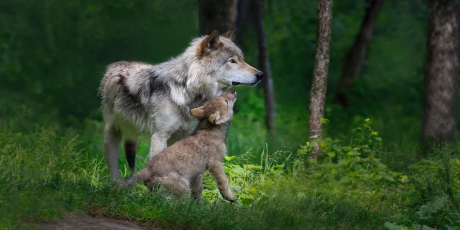Why it's too soon to bring wolves back to Ireland 04 Apr 2024

Analysis: Reintroducing wolves may be a nature-based solution to biodiversity and ecological issues, but we're simply not ready for them - Dr. Paddy Sleeman, School of Biological Earth and Environemental Sciences and the Environmental Research Institute, UCC
The urgent climate and biodiversity crisis needs solutions. Encouraging trees is part of this, but high deer densities in Ireland are destroying forests by eating saplings. Top predators can have a big effect on prey, such as deer, and humans usually eliminate such predators as they are dangerous and competition. these predators include lions in Africa or tigers in Asia and, most frequently, wolves.
Like humans, wolves are successful by being social and ecologically flexible. But wolves went extinct around 1700 in Ireland and could not be re-introduced without universal good will. The mooted re-introduction of wolves to Ireland is seen as a panacea for the problem with trees. Not only will wolves influence deer number but more importantly, they create 'landscapes of fear'. Usually a vigilant and healthy deer can easily out run a pack of wolves. But there are places where deer may be more readily cornered and killed by a wolf pack, like rivers and roads, and these are landscapes of fear.
Avoided by deer, trees can grow in these places, and trees thrive on the rivers’ banks, which helps in decreasing floodings, filtering water, as well as increasing woodlands. By making roads ‘landscapes of fear’, deer avoid them and therefore there are fewer deer traffic accidents. All very nature-based and useful.
We know from road casualties there are lots of foxes and badgers, these cause ecological problems. Foxes when very plentiful such as now, cause declines in ground nesting birds. Badgers, which are again plentiful, harbour bovine tuberculosis which spills over to cattle. Wolves, (and lynx), specifically focus on killing foxes and badgers, making them wary and less common, which would help the ground nesting birds.
And this can help with diseases. Wolves in Spain remove wild boars with bovine tuberculosis, which is very cost effective, so perhaps the same would happen with badgers? And indeed make the entire ecosystem, by removing the sick and the weak, healthier. However there are communities, both of people, animals, and plant communities, that have issues that would need to be resolved.
People who live in rural communities must be on board with re-introductions, especially those directly affected, and likely to encounter wolves, like stock owners, especially sheep farmers, deer hunters and dog owners, all of whom will be impacted. Wolves are especially prone to attack and kill dogs which is why in areas where wolves occur, dogs tend to be large, fierce and sometimes have studded collars, to prevent wolves attacking their throats.
From Encyclopaedia Britannica, wolves return to Denmark after 200 years
The rural way of life will be threatened and massive preparation would be needed. It ought to be by consent, which means it will be a long time coming, if ever. Also such reintroductions would need robust, legal underpinning, and one this small island all of this would apply both north and south. Sufficiently large areas of suitable habitats of plant and animal communities would be needed which, for lynx at least, are unavailable now in Ireland . With afforestation, this may change, but its possible it will be frustrated by high deer numbers.
Not only this, but sufficient available wild prey will also need to be present all year round, and we know that re-introduced golden eagles' first chicks were fed badger cubs, not anyone’s idea of ideal prey. In Donegal the eagles had problems getting sufficient prey due to foxes. In the words of the International Union for Conservation of Nature’s Guidelines for re-introductions there "should generally be strong evidence that the threat(s) that caused any previous extinction have been correctly identified and removed".
From The National Museum of Ireland, how the wolf went extinct in Ireland
But we are not there yet. The problem is at an ecological level, but the species which holds the panacea here are not the wolves, but us. For years, we have tinkered with the symptoms of the ecological malaise, rather than the cause. These symptoms can be seen all around us: floods, heat, rising seas lowering biodiversity, and as we have seen, too many deer holding back trees, too many foxes and badgers zapping ground nesting birds.
Our demands for stuff, most especially energy and specifically fossils fuel energy, prompted this and we need to understand why we ‘must have’ this. Recent research pointed out that our evolutionary drives to ‘belong to the tribe’ and ‘signal status to attract mates’ are hijacked by marketing to push up our consumption. As climate scientist Phoebe Barnard, an author of that paper, says ‘use them to build a genuinely sustainable world’.
No doubt wolves will be back, and indeed already are across Europe and much of America. For us on these islands, this is decades away or more. In the meanwhile, we need to prompt a ‘landscape of fear’ and cull deer ourselves until populations reach a level at which trees can grow.